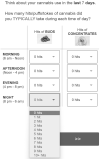Typical Hits, Grams, or Joints: Evaluating Cannabis Survey Measurement Strategies for Quantifying Consumption
- PMID: 36577020
- PMCID: PMC10998027
- DOI: 10.1089/can.2022.0237
Typical Hits, Grams, or Joints: Evaluating Cannabis Survey Measurement Strategies for Quantifying Consumption
Abstract
Aim: Standardized survey measures that capture diverse cannabis consumption patterns are needed to inform public health and policy. Our team is developing a flexible, personalized, low-burden survey item inventory to measure cannabis use patterns and estimate milligrams of THC (mgTHC) consumption in large samples. This study aimed to identify measurement gaps and analysis implications associated with an initial pool of candidate items that assessed use of cannabis flower and concentrate products (smoked and/or vaporized). Methods: Adult cannabis consumers (n=4247) completed an online survey assessing cannabis use frequency, quantity, product types, product potencies (%THC), and methods of administration. Participants chose to report their consumption quantities using one of three units: "hits per day," "grams per week," or "joints per week." Respondents also indicated whether their past 7-day consumption pattern represented their typical pattern. Results: Eighty-one percent had used cannabis daily in the past week. Thirty-two percent, 53%, and 15% chose to report flower and concentrate consumption quantity in hits, grams, and joints, respectively. Approximately 80-90% of responses for the number of hits, grams, and joints consumed were less than the maximum response option-suggesting that response options captured the full range of potential cannabis consumption behaviors. Those who chose grams or joints units were generally more likely to endorse higher risk cannabis use (e.g., morning use, high %THC products) in the past week than those who chose the hits unit (adjusted Odds Ratio range: 1.2-3.9). Among those who reported that the past week represented their typical behavior (83%), past 30-day and past 7-day frequencies were highly correlated (Spearman's Rho=0.77)-supporting the feasibility of using lower burden "typical week" items to extrapolate patterns beyond a 1-week time frame. Conclusion: Results from this online convenience sample of frequent cannabis consumers suggest that the current items yield coherent and expected response patterns. Although additional testing is required, a standardized, flexible survey instrument for large-scale assessment of cannabis patterns and calculation of mgTHC seems within reach.
Keywords: THC; cannabis; measurement; quantity; survey.
Conflict of interest statement
Dr. A.J.B. reports funding from NIDA as well as being a member of the Scientific Review Board of Canopy Growth and a consultant for Jazz Pharmaceuticals. All other authors of this article have no conflicts of interest to report.
Figures





References
MeSH terms
Substances
Grants and funding
LinkOut - more resources
Full Text Sources
Miscellaneous

